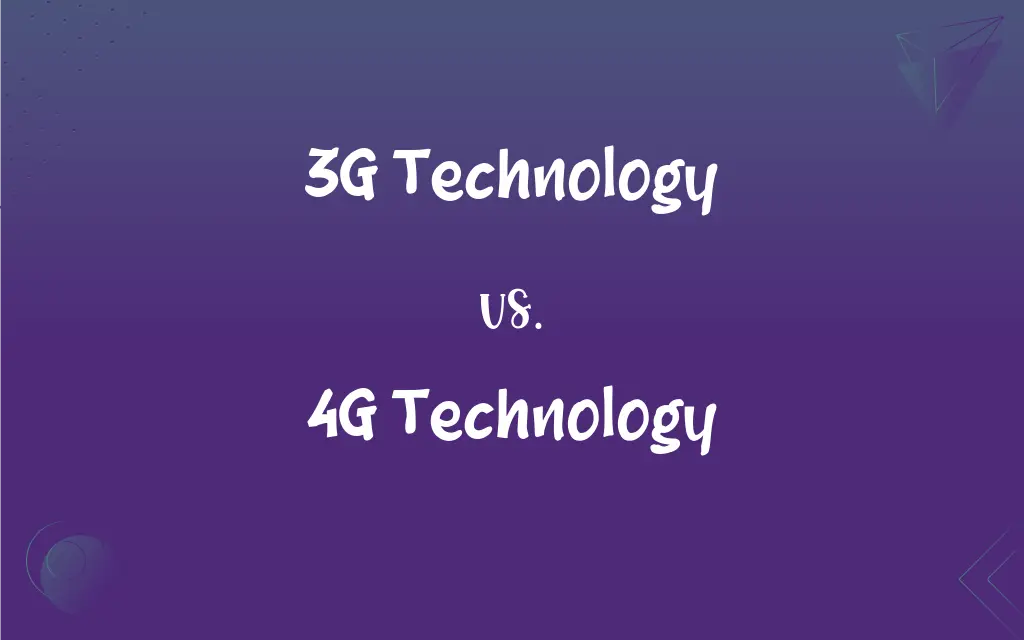3G Technology vs. 4G Technology: What's the Difference?
Edited by Aimie Carlson || By Janet White || Published on November 8, 2024
3G Technology offers mobile telephony and data services with improved speed over 2G, while 4G Technology provides higher speed, improved efficiency, and supports advanced applications like HD streaming.

Key Differences
3G Technology, the third generation of mobile telecommunications, introduced faster data transmission, enabling services like mobile internet and video calls. 4G Technology, the fourth generation, significantly enhanced these capabilities, offering higher speeds and better reliability, making streaming of high-definition (HD) content and smoother video conferencing possible.
The data speeds in 3G networks typically range from 200 kbps to a few Mbps, sufficient for basic internet browsing and email. In contrast, 4G networks can reach speeds of 100 Mbps to 1 Gbps, facilitating faster web browsing, file downloads, and high-quality video streaming.
3G networks use a combination of technologies including UMTS and HSPA, focusing on enhancing mobile voice and data services. 4G networks, however, primarily use Long Term Evolution (LTE) technology, which emphasizes data transmission, offering improved network capacity and efficiency.
In terms of network architecture, 3G relies on a wide area cell-based approach with a mix of large and small cells. 4G employs a more integrated approach with advanced technologies like MIMO (Multiple Input Multiple Output) and OFDM (Orthogonal Frequency Division Multiplexing), leading to increased capacity and better coverage.
3G marked a significant leap from 2G by enabling smartphones to access the internet, whereas 4G took this further by making it feasible to replace traditional broadband services in homes and offices with mobile internet, thanks to its higher speeds and lower latency.
ADVERTISEMENT
Comparison Chart
Data Speed
Ranges from 200 kbps to a few Mbps
Ranges from 100 Mbps to 1 Gbps
Primary Technologies
UMTS, HSPA
LTE, WiMAX
Network Architecture
Wide area cell-based network
Advanced technologies like MIMO and OFDM
Key Features
Mobile internet, video calls
HD streaming, high-speed downloads, low latency
Impact on Mobile Devices
Enabled smartphones with basic internet access
Allowed smartphones to replace traditional broadband
ADVERTISEMENT
3G Technology and 4G Technology Definitions
3G Technology
It provides improved data transmission over 2G.
3G technology made it possible to send emails from mobile devices.
4G Technology
It supports advanced applications like HD streaming.
Watching live sports in high definition is possible because of 4G technology.
3G Technology
3G uses technologies including UMTS and HSPA.
The 3G network in her area relies on UMTS technology.
4G Technology
4G can replace traditional broadband with mobile internet.
They use 4G technology at home for all their internet needs.
3G Technology
3G is the third generation of mobile telecommunications technology.
Her smartphone uses 3G technology for internet browsing.
4G Technology
4G primarily uses LTE for improved data transmission.
The 4G LTE network provides quick download speeds.
3G Technology
3G supports services like mobile internet and video calls.
Using 3G technology, he made a video call while on the move.
4G Technology
It offers higher speeds and better reliability than 3G.
Streaming HD videos is seamless with 4G technology.
3G Technology
3G marked a leap in mobile internet access.
With 3G technology, accessing the web on phones became commonplace.
4G Technology
4G is the fourth generation of mobile telecommunications technology.
His phone's fast internet speed is due to 4G technology.
FAQs
What is 4G technology?
The fourth generation of mobile telecommunications technology.
What is 3G technology?
The third generation of mobile telecommunications technology.
How fast is 3G compared to 4G?
4G is significantly faster than 3G.
Can 4G technology support video streaming?
Yes, 4G efficiently supports high-definition video streaming.
Is 3G technology still widely used?
It's being phased out in favor of 4G and 5G.
What are the primary uses of 3G technology?
Mobile internet browsing and basic video calls.
What technology underpins 4G networks?
Primarily LTE (Long Term Evolution).
Can 4G replace wired internet?
In many cases, yes, due to its high speed and reliability.
Can 3G phones work on 4G networks?
They can, but only at 3G speeds.
Are 4G networks more efficient than 3G?
Yes, 4G networks are more efficient and have higher capacity.
Is 3G good enough for basic internet tasks?
Yes, for basic tasks like emailing and web browsing.
Do I need a new phone to use 4G?
Yes, if your current phone only supports 3G.
How has 4G impacted mobile communication?
It has greatly enhanced mobile internet and communication.
Will 3G be phased out?
Yes, it's gradually being replaced by 4G and 5G.
What's the main benefit of 4G over 3G?
Higher speeds and improved data transmission.
Is 4G available everywhere?
Coverage is widespread but not universal.
Does 4G consume more data than 3G?
Potentially, as higher speeds may lead to increased data usage.
What are the disadvantages of 3G?
Lower speeds and less efficiency compared to 4G.
Is 4G better for gaming on phones?
Yes, due to its lower latency and faster speeds.
Can I use 4G for home internet?
Yes, many use it as a primary or backup home internet solution.
About Author
Written by
Janet WhiteJanet White has been an esteemed writer and blogger for Difference Wiki. Holding a Master's degree in Science and Medical Journalism from the prestigious Boston University, she has consistently demonstrated her expertise and passion for her field. When she's not immersed in her work, Janet relishes her time exercising, delving into a good book, and cherishing moments with friends and family.
Edited by
Aimie CarlsonAimie Carlson, holding a master's degree in English literature, is a fervent English language enthusiast. She lends her writing talents to Difference Wiki, a prominent website that specializes in comparisons, offering readers insightful analyses that both captivate and inform.







































































